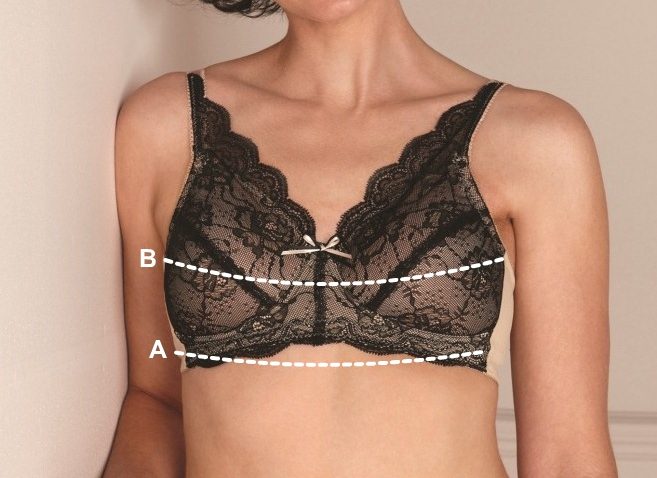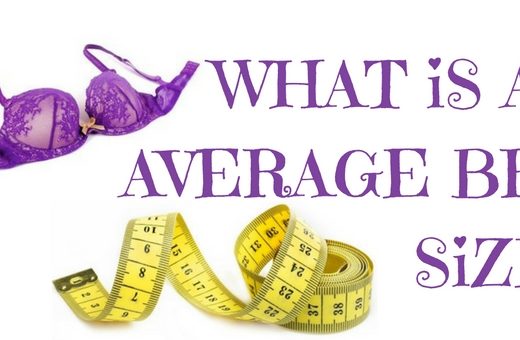Bra sizes basically depend on the band sizes and cup sizes of the particular bras, usually consists of numbers and alphabets. In 1932, bra cup sizes were invented and band sizes became popular only in 1940s.
All the women differ from each other in shape, size, spacing, position, symmetry and firmness. The bra manufacturers produce bras of limited ranges from smallest to largest targeting to fit the maximum numbers of women.
Since there is not anything like International standard for the bra size, the labeling of the sizes vary from country to country, manufacturer to manufacturer. Pechter, in his study ‘A New Method for Determining Bra Size and Predicting Postaugmentation Breast Size’, found that bra label size was consistently different from the measured size even within the same country.
This is the reason why women find it difficult to find the perfect fitting bra. Hence some women opt for the custom-made bras.
The Origin of the Cup
As mentioned in Uplift: The Bra in America by Farrell-Beck and Gau (2002), the term ‘cup’ was not use to describe bras until 1916.
The S.H. Camp and Company were the first to measure cup size by the alphabets A, B, C and D, in October 1932. Those letters represented how droopy are the breasts and not their volume. Cup sizes A through D were not meant to be for the smaller to the larger-breasted women.
Warner introduced these four cup sizes, A, B, C, and D for its products in 1937. These cup sizes got the nicknames; egg cup, tea cup, coffee cup and challenge cup as stated by Eisenberg & Eisenberg in The Scoop on Breasts: A Plastic Surgeon Busts the Myths (2012). The two other companies offered the A, B, C, and D cup sizes in late 1930s.
Though the alphabetical cup sizes were introduced back in 1930s, the catalog companies continued using labels of small, medium and large through 1940s. Britain refused to go along with the American cup sizes until 1948. Sears Company applied cup sizes to bras in its catalog in the 1950s.
Also Read: Bra Sister Size: Why you should know about it?
The Origin of the Band
Though the adjustable bands were introduced in 1930s using the multiple hook and eye closures, band size became popular only in 1940s. American bra manufacturers started band measurement system after the Second World War.

It has been almost 7 decades since the bras were first introduced, yet the band sizes and cup sizes are not standardized. The sizes vary significantly from one manufacturer to another providing just the fairly accurate fit. This complicates finding the correctly fitting bra and women cannot rely on the labeled bra sizes. This is the reason why most women are wearing the wrong size bras.
The bra size is determined by the band size and cup size. Band size measurement is taken by measuring the body around the base of the breasts. Cup size is determined by the difference between the bust measurement and band measurement. Some manufacturers measure in inches and some in centimeters, thus creating the difference. And the manufacturers are not coming together to agree on a single standard.
The cup size increases from A to D, from smallest to the largest. These days manufacturers produce bra of bigger sizes such as G, H, and so on for the larger breasted women. British manufacturers produce bra from A to LL cup size while in America bras from A-G cup sizes are found. The largest cup size found is N (Goddess, Elila) which is roughly equal to British JJ cup. Poland produces up to R cup size.
The thing is larger cup sizes are difficult to get in retail outlets. And with the increasing cup size the labeled cup sizes tend to vary from manufacturer to manufacturer more widely.
Bras are small pieces of clothing yet the most complex piece of apparel. There are various styles and each style has various sizes.
Variation in cup sizes
Cup sizes vary from country to country, manufacturer to manufacturer. The larger the cup size the greater the variation.
Below is the bra size chart of U.S., U.K. and Australia:
| Difference
(inches) |
<1 | 1 | 2 | 3 | 4 | 5 | 6 | 7 | 8 | 9 | 10 | 11 | 12 | 13 | 14 | 15 | 16 | 17 |
| Cupsize U.S. | AA | A | B | C | D | DD/E | DDD/F | DDDD/G | H | I | J | K | L | M | N | O | – | – |
| Cupsize U.K./Australia | AA | A | B | C | D | DD | E | F | FF | G | GG | H | HH | J | JJ | K | KK | L |
Let alone the bra sizes, even the surveys of bra sizes tend to vary depending on the population studied. In a survey conducted by Triumph in 2007, it was found that 57% of British women need a D cup that is more than any other country.
Below is the table showing the result of Triumph Survey:
| Country | D | C | B | A |
| UK | 57% | 18% | 19% | 6% |
| Denmark | 50% | 19% | 24% | 7% |
| Netherlands | 36% | 27% | 29% | 8% |
| Belgium | 28% | 28% | 35% | 9% |
| France | 26% | 29% | 38% | 7% |
| Sweden | 24% | 30% | 33% | 14% |
| Greece | 23% | 28% | 40% | 9% |
| Switzerland | 19% | 24% | 43% | 14% |
| Austria | 11% | 27% | 51% | 10% |
| Italy | 10% | 21% | 68% | 1% |
Also Read: Why most women wear wrong size bra?
Manufacturer Standards of bra sizes
Of course, the bra sizes vary all across the world. Since the bra size labeling system differs from brand to brand, country to country, women can to some extent reduce the difficulty of finding the perfect fitting bra by choosing one country and one brand that fits more properly than the others.
Below is the bra size chart showing the approximate band size equivalents between various systems:
| Underbust (cm) | 58-62 | 63-67 | 68-72 | 73-77 | 78-82 | 83-87 | 88-92 | 93-97 | 98-102 | 103-107 | 108-112 | 113-117 | 118-122 | 123-127 | 128-132 | 133-142 | 143+ |
| EU | 60 | 65 | 70 | 75 | 80 | 85 | 90 | 95 | 100 | 105 | 110 | 115 | 120 | 125 | 130 | 135 | 140 |
| FR, BE,ES | 75 | 80 | 85 | 90 | 95 | 100 | 105 | 110 | 115 | 120 | 125 | 130 | 135 | 140 | 145 | 150 | 155 |
| IT | 0 | 1 | 2 | 3 | 4 | 5 | 6 | 7 | 8 | 9 | 10 | 11 | 12 | 13 | 14 | 15 | 16 |
| US, UK (in) | 28 | 30 | 32 | 34 | 36 | 38 | 40 | 42 | 44 | 46 | 48 | 50 | 52 | 54 | 56 | 58 | 60 |
| AU, NZ | 6 | 8 | 10 | 12 | 14 | 16 | 18 | 20 | 22 | 24 | 26 | 28 | 30 | 32 | 34 | 36 | 38 |
| UK dress | 4 | 6 | 8 | 10 | 12 | 14 | 16 | 18 | 20 | 22 | 24 | 26 | 28 | 30 | 32 | 34 | 36 |

Different countries have different sizing systems. Most of them use the chest circumference measurement and lettered cup sizes but still there are noticeable differences.
United States and Canada
In the United States and Canada, band sizes are measured in inches and cup sizes increase by 1-inch steps. However, labeling of the bra size still varies. Some label bra beyond C cup as D-DD-DDD-DDDD-E-EE-EEE… and some as D1, D2, D3, D4, and so on. But majority follows the system of A, B, C, D, DD, DDD, G, H, I, J, K, L, M, N, and O.
Jockey International introduced new way of measuring bra and cup sizes in 2013. It introduced ten cup sizes per band size and those were numbered instead of letters, labeled as 1-36, 2-36, and so on.
UK
Like in US and Canada, UK also uses the inch system to measure the band size and cup sizes increase by 1-inch steps, or 2.54 cm. The British standard band sizes are 28-30-32-34-36-38-40-42-44, and so on. Cup sizes are labeled as AA-A-B-C-D-DD-E-F-FF-G-GG-H-HH-J-JJ-KK-L.
Leading brands like Panache, Bestform, Freya, Curvy Kate, Bravissimo and Fantasie use the British standard sizes while some companies like Marks and Spencers, Evans and ASDA sell bras of their own custom sizes.
Australia/New Zealand
Both Australia and New Zealand use the permutation of the British system. They use the same cup sizes but Australia’s bra band size is based o dress sizing charts. Since the dress sizes and cuts are calculated for B and C cups only, basing the band size upon the dress size is not accurate way to get the bra size.
Continental Europe
In continental Europe, band size is measure in centimeters and rounded to the nearest multiple of 5 cm. Hence, the band sizes are 65-70-75-80-… and so on, increasing 5 cm a step.
The cup size labels starts with AA for 11±1 cm difference between bust and underbust circumference. They increase by 2 cm a step, instead of 2.5 cm or 1 inch like UK and US. This is standardized system for European dress size, EN 13402, which was introduced in 2006.
Below is the list of bra sizes of Continental Europe:
| Cup Size | Band Size | |||||
| Difference (cm) | Cup | Underbust circumference (cm) | Bust size | Underbust size | ||
| FR/BE/ES | EU | IT | ||||
| 10-12 | AA | 58-62 | 75 | 60 | 0 | |
| 12-14 | A | 63-67 | 80 | 65 | 1 | I |
| 14-16 | B | 68-72 | 85 | 70 | 2 | II |
| 16-18 | C | 73-77 | 90 | 75 | 3 | III |
| 18-20 | D | 78-82 | 95 | 80 | 4 | IV, IIII |
| 20-22 | E | 83-87 | 100 | 85 | 5 | V |
| 22-24 | F | 88-92 | 105 | 90 | 6 | VI |
| 24-26 | G | 93-97 | 110 | 95 | 7 | VII |
| 26-28 | H | 98-102 | 115 | 100 | 8 | VIII |
| 103-107 | 120 | 105 | 9 | IX, VIIII | ||
| 108-112 | 125 | 110 | 10 | X | ||
Index: FR = France, BE = Belgium, ES = Spain, IT = Italy
French, Belgian and Spanish system of bra size is a permutation of the Continental European sizing system. Though the cup sizes are the same, band sizes are exactly 15 cm larger than the European band size.
The Italian band sizes are in Roman numerals and uses small consecutive integers. It starts with size 0 for European size 60.
South Korea/Japan
Like Continental Europe, South Korea and Japan also measures torso in centimeters and rounds to the nearest multiple of 5 cm. Band sizes start from 65-70-75-80… and so on, increasing 5 cm a step.
The cup size for South Korea begins from AAA for 5±1.25 cm difference between bust and underbust circumference. They increase 2.5 cm a step, except for the initial cup size letters. Japanese cup sizes begin with AA for 7.5±1.25 cm difference and precedes the bust size, for example, ‘B75’ instead of ‘75B’.
These are standardized size in both Korea dress size, KS K9404 in 1999 and Japan dress size, JIS L4006 in 1998.
Hence, the measurement system for band size and cup size varies across the world. The best thing to do to find the perfect fitting bra would be measuring bra size yourself and finding the closest fit.
Also Read: How to measure bra size?
If you want to know how to measure bra size at home, click here.
Was this post helpful? Please let us know in the comment section below.
Thank you!





9 Comments
[…] You can know more about bra sizes here. […]
Such an informative article it is….Thanks for writing it.
prise de la masse musculaire
such a nice and informative article
very informative and best article that i have ever read.keep posting such informative articles.
Hahahahahahaha. Fake stats. The Country with the biggest natural cup size is Russia. Next to the Czech Republic followed by Poland (all, of course, are Slavic origins). 65% of Russian women over age 25 are D or bigger. However, most of the other Countries you list are due to obesity. Russian has the greatest percentage of slim body and D or larger cups by far.
Thank you so much very informative and very unique information
i have learn a lot here i always buy a wrong size for my bra,i did not know which size of my cup is ,but now i know
how to sale bra in online…can you tell me